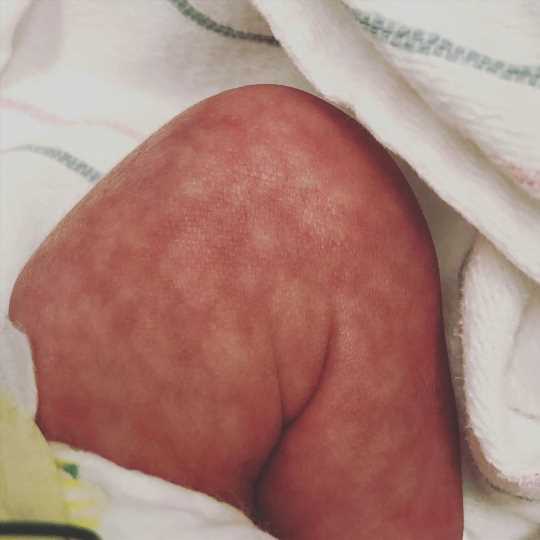MOTTLED skin is condition which shows up as red or purple marks, streaks, or spots on the skin.
One expert has explained why some kids are more prone to the condition than others.


If your baby has patchy skin that often looks as though it's different colours, they could have mottled skin, also known as livedo reticularis.
There are a number of reasons why your child might have skin like this.
With mottled skin – there are six main causes and one paramedic has explained some of the most common.
Nikki, who runs the tinyheartseducation Instagram page said mottling is a pattern of small darker and pale areas that may look like a web or lacework on child's skin.
She explained that newborn babies – and especially premature ones are more prone to it.
Most read in Health

Most common day to suffer a serious heart attack revealed – are you at risk?

Urgent warning as porn addiction cases 'DOUBLE in a year' – the signs revealed

I'm a dietitian – here's 5 foods that help lower dangerously high blood pressure

I'm a dermatologist – here's 5 budget anti-ageing skincare buys that REALLY work
Why does my child’s skin look mottled?
Here are the six main reasons why your child might be experiencing mottled skin
- Premature and newborn babies
- Shock
- Cold environment
- Infections
- Lupus
- Medication
How to treat it?
Mottled skin usually goes away on its own and in most cases will disappear once warmth is applied.
Treatment will depend on the cause and could involve taking an anticoagulant and treating the infection – if there is one present.
Blood pressure drugs are also sometimes prescribed.
"This is common in newborns because their circulation is still a little unstable and highly sensitive to change.
"Premmie bubs are more likely to become mottled as their temperature regulation may not yet be fully developed.
"A tendency to mottle will usually resolve between 6-12 months of age."
CALL 999
Shock can also cause mottled skin, said Nikki, especially in older children.
She added: "Mottling in older children and adults can be a sign of shock when accompanied by other symptoms.
"If you notice breathing problems, weakness or fainting, larger than normal pupils or nausea and vomiting your little one may be in shock and it's time to call an ambulance."
If your child has an infection, they may have mottled skin and this is because severe infections such rheumatic fever and sepsis can trigger skin discolouration and mottling.
It's important to call 999 immediately if you think you child has sepsis.
One of the main causes of mottled skin is a cold environment, so getting rid of it could be as easy as wrapping up warm.
It could also cause the child to shiver.
Mottled skin has also previously been linked to certain medications and your health care practitioner will usually warn you when prescribing the medication that this could be a side effect.
Most drugs have side effects and it's important that you read the label and consult a professional before starting a new course of medication.
Drugs used to treat Parkinson's, ADHD and multiple sclerosis have all been linked to mottled skin as have some anti-inflammatory drugs.
Read More on The Sun

Holly Willoughby arrives at ITV for first This Morning show since Phillip exit

BGT fans shocked as live audience ‘boo’ judge within seconds of final starting
Lupus is also a key cause of mottled skin and a quarter of people with the autoimmune condition will suffer from it.
Lupus inflames the skin and blood vessels and others symptoms linked to the condition include a rash on the face and sensitivity to sunlight.
Source: Read Full Article


